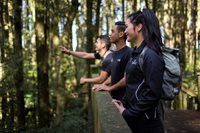The ability to immerse oneself within another Pacific culture inspires Te Wānanga o Aotearoa kaiako Kimoro Taiepa to keep extending himself as a performing artist.
And after travelling to Honolulu to compete in the King Kamehameha hula competition, the kapa haka proponent has gained even more inspiration.
The annual international hula competition - which is in its 43rd year - was notable this year for the inclusion of Kimoro's composition, Halau O Moananuiakiwa, the first New Zealand-based entry and which came about through the tutelage of Kumu Auli'i Mitchell.
Auli'I was one of the first graduates of He Waka Hiringa - Master of Applied Indigenous Knowledge, and created a school in 2013 as a space to explore and demonstrate concepts he was researching.
Kimoro was first introduced to hula in 2004, but it was after attending Auli'I's body of work from his Master's, Ho'ike, that he began to explore the elements that make up hula.
"Ho'ike was the bringing together of the performance, the dress and the knowledge of hula practice and Moananuiakiwa was an outlet for the presentation of Auli'i's ideas and his own particular style, passed down through his family," Kimoro says.
All of Kimoro's halau performers were steeped in traditional and contemporary dance and included Māori, Samoan and Rarotonga performers, creating a perfect opportunity for exchange.
"Our name says it all - Temoananuiakiwa is about kotahitanga, culture and our relationship with each other and with nature. The buildup, the preparation, it was a journey for us around the spiritual art of hula with a lot of the peripheral becoming a total immersion in the culture," Kimoro says.
"Coming from a Pacific arts background I wanted to experience how our cousins taught their tauira and how they viewed the world. It's like parallel tikanga, expressed or exercised in slightly different ways but the DNA is still the same. To find that common thread enhanced my own identity."
For the King Kamehameha performance, the Tuhoe, Tainui and Te Arawa kaiako composed and sang the halau's auana (modern) dance piece, which was based on the Mt Tarawera eruption.
Kimoro says it was a privilege to perform with renowned auana composer, Kumu Tony Conjagacian, and his trio of musicians and the group looked forward to working with Tony again next year.
"To be critiqued by hula exponents was an enriching experience and to bring our own tanga and utilise our matauranga into the performance made it unique," he says.
"I love the learning, the innovation and the creativity of our Hawaiian cousins, in terms of years of wisdom and to be able to reconcile our own ancient thinking through someone else's lenses. Hula is that heartbeat, the rhythm of life and it brings together people so Moananuiakiwa is exactly that - making connections through our Pacific bloodlines."




































